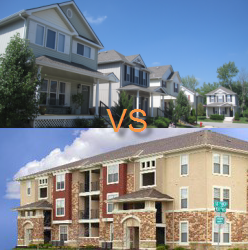
A man and his realtor walk down the street and the man says “Realtor, I want to buy that house,” pointing to a beautiful 3 bedroom 2 bath home, “What should I offer?” The realtor responds, “Well, I’ve looked at the comparable sales in the neighborhood and it looks like another 3 bedroom, 2 bathroom home sold for $100,000 just last month. I would offer them $100,000.” The man agrees and buys the home.
The next week, the same man comes back up to his realtor and says “Realtor, I love my new home, but I had a great year at work and have some extra money that I want to invest. I heard that the retail center up the street is for sale. I saw the one across the street just sold for $500,000 and was identical. Should I offer $500,000?” The realtor responds, “Let me check the sale price.” The realtor makes a few calls and comes back to tell the man the news. “Well,” says the man, “Can I buy it?” The realtor then tells the man the news, “That retail center is for sale for $1,000,000. Maybe we should look at something else?” The man, looking confused, thinks for a minute and then says, “how could that be? They are identical in size and just across the street. Why is that one worth twice as much?”
Before we answer his question, let’s take a quick look at how property values are determined (Be sure to check out our free report – Identifying High Performance Real Estate Investments to learn how to determine investment property values.
Let’s first take a look at residential properties.
We define residential properties as single family homes. Homes are traditionally purchased as a place to live by their owner. They can also be purchased as rental properties. But, because the percentage of homes purchased as rentals is relatively small when compared to the single family home market as a whole, their valuation is based on the same methods.
Home prices are determined by using a few different comparable sale methods. These comparable sale methods are done by using cost per square foot, cost of construction, or floor plans. These valuation methods are also applied for duplexes and four-plexes.
For instance, let’s say a home sells in your neighborhood for $100,000. It has 2 bedroom and 1.5 baths. It is similar in style and size to your home. When you go to sell your home, the realtor will probably tell you that it is worth $100,000 after looking at the comparable sale.
Determining residential home value is straightforward and relatively easy to do. You look at similar homes and what they sold for, then adjust for any differences, and you can quickly determine the value.
We define commercial real estate as properties that produce income. They consist of apartment complexes of 12 units or more, or office, retail, and industrial buildings. These buildings are primarily owned by investors. These investors do not live there, but rent them out to tenants who pay rent each month for their space.
Commercial real estate value is determined by the income it generates. Income is calculated by taking the rental income and subtracting out the operating expenses. You do not factor in loan payments or income taxes. The amount that is left is called the Net Operating Income.
If you want to invest in commercial real estate, you must know how to calculate the Net Operating Income.
Commercial property value is determined by how much an investor is willing to pay for the Net Operating Income. The investor trades their investment dollars for the property’s income. The rate that the income pays back to the investor for their investment is called the return on investment. The sales price is determined by how much the investor is willing to pay for projected Net Operating Income.
Let’s say that an investor is considering purchasing a retail center or apartment complex that has a Net Operating Income of $100,000. In that area, investors are willing to buy properties like this for a 10% return on investment.
In this case, the property would be worth $1,000,000. The value is determined by taking the Net Operating Income divided by the desired return on investment ($100,000/10%= $1,000,000) for investors in your area. This means if an investor were to invest $1,000,000, he would expect to receive a 10% return on his investment each year ($100,000).
Now that you know how values are determined, let’s get back to the realtor’s answer to the investor’s question on how the two property’s values could be so different.
“The reason,” the realtor answered, “is because this property has better tenants and generates more income than the one across the street.”
What the investor initially failed to see is that he wasn’t just investing in the buildings as you do in residential real estate. The buildings were identical. He was actually investing in the tenants, the leases, and income that is generated by them, not the buildings themselves. Once he realized that, he looked again and it was easy to see why the values were different.
When he looked again, he noticed that the second building had higher quality tenants, a thriving restaurant, and was obviously doing more sales. “Oh, I see… because that retail center does more in sales, it can charge more for rent. When it does, it produces more income. Right?”
“Yes” said the realtor. “Why don’t we go grab some lunch and we can talk about locating the right property for you?”

